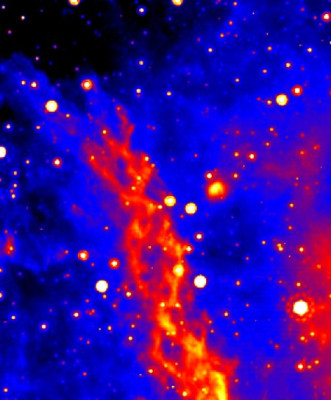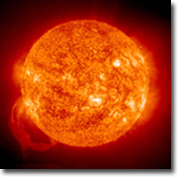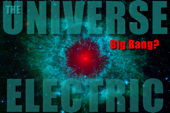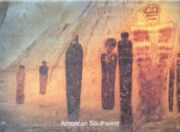Milky Way's Birkeland Current Falsifies "Black Hole" Assumption
06/23/08
Anatomy of the Milky Way core
At present, we find ourselves in the unsatisfying position
of having remarkable new observational insight into the
nature of the galactic center but lacking a sturdy
interpretive framework. - Robert L.
Brown and Harvey S. Listz
"Sagittarius A and it's Environment"
Annual Review of Astronomy and Astrophysics
Written in 1984 it appears that since then things have only
worsened.
According to some estimates the bright radio source known as
Sagittarius A* (pronounced A-star), residing at the heart of our Milky Way galaxy, is more
than 50 light-years wide. It's radio glow stems from synchrotron
radiation, the result of charged particles spiraling around magnetic
field lines at relativistic speeds. Assumptions have been made that
the Sag A* complex is the result of a massive black hole. Yet, save
for mathematical computer models based on gravitational conjecture,
not a single black hole has ever been found. Might the well known
plasma dynamics of an electric universe reveal the true nature of the
Milky Way's galactic center?
The central most region of our galaxy is filled with a variety of
dense molecular clouds (plasma). A variety of factors such as
temperature, chemical composition, bulk velocity etc are known to
separate plasma of differing characteristics into separate molecular
clouds. This self-organization is a fundamental aspect of plasma and
is the 'life like' quality that prompted Irving Langmuir to so name
them after blood plasma.
The Sagittarius A complex is divided into "Sag A East" and "Sag A
West". Running perpendicular to the galactic plane is a series of
filaments known to be magnetic called the Arc. They collectively form
a long linearly polarized filament that appears to also interact with
other molecular clouds but the filaments do not appear to be
deflected by that interaction. That characteristic and their
perpendicular relationship also implies that the "threads" composing
the Arc are tracing the path of magnetic field lines.
One of these molecular clouds is known as "M-0.02-0.07" or simply
the "50 km s-1 cloud". This particular
dense cloud of plasma, often mistakenly called a "gas", is considered
"unique" due to high levels of energetic activity. This energetic
activity is the result of an interaction which produces the central
"plasma-focused plasmoid" and non-thermal filamentation as explained in
Galaxy Filaments.
Wheel within a Wheel
Within the brightest region of Sagittarius A* yet another dynamic
feature resides. It is known as the "circumnuclear disk" and has been
described as an orbiting oval shaped ring of "molecular gas".
However, that description belittles the true nature of the Milky Way
galaxy's plasma torus.
At an estimated 100 kilometers per second the plasma torus appears
to orbit, and is said to "feed" the central 7 light-year wide feature
known as the "
Mini-Spiral".
The "wheel within a wheel" of our Milky Way galaxy. The
Mini-Spiral is composed of the "Eastern Arm", the "Western Arc", the
"Northern Arm" and all three appear to be joined at a relatively
small central "bar" such as those which distinguish barred spiral
galaxies from spiral galaxies.
Astrophysicists are generally at great pains to determine
the cause of such highly energetic activity but not one of their
number has, or can, explain how their gravity only universe can
account for the wide variety of compelling features collectively
embodied in the Milky Way's galactic nucleus.
It's "wheel within a wheel", or the "Mini-Spiral", has
sent them scrambling for any number of assumptive gravitational
scenarios such as 'tidally stretched and disrupted clouds',
"gravitational potential due to the point-mass", "accretion disk",
explosive "blast waves" from supernova - although the magnitude of
Sag A* refutes that notion, 'molecular cloud collisions', "shock
models", and of course a theoretical black hole "with over
2 million
times the mass of the Sun." Or is it
3.7 million solar masses?
3.6? Maybe
4 million?
But no one has explained how so many supposedly "young stars" and
star clusters, such as The Arches Cluster, and The Quintuplet Cluster
can exist in a region so close to an alleged black hole.
In it's attempts to wrestle with the cause of anomalous
gravitational behavior modern astrophysics inadvertently
misconstrues the known plasma dynamic of self-organization and
reinterprets the observed behavior as "self-consistent". Atop this
interpretation any number of gravitational scenarios and inferences
are then placed. The conventional theory of stellar formation via
gravitational collapse fails at galactic center. For example:
According to
the standard model for star formation, gas clouds from which stars
form should have been ripped apart by tidal forces from the
supermassive black hole. Evidently, the
gravity of a dense disk of gas around Sagittarius A* offsets the
tidal forces and allows stars to form. The tug-of-war between the
black hole's tidal forces and the gravity of the disk has also
favored the formation of a much higher proportion of massive stars
than normal. -
Chandra:
"Stars Surprisingly Form in Extreme Environment Around Milky Way's
Black Hole" [Emphasis added]
And also:
Finding such big
star clusters so near the gravitational pull of the galactic center
is surprising; tidal forces should rip them
apart. - Angelle
Tanner, Sky & Telescope
When observation contradicts the gravity only cosmology the result
is to immediately 'morph' the supposed gravitational characteristics
of the ever pliable theoretical black hole. It is habitually done on
autopilot.
Not only do we see the 'scavenging' of plasma via well known
Marklund Convection which "convects radially
inwards, with the normal E x B/B2 velocity, towards the center of a
cylindrical flux tube " it has been a lack of familiarity with
plasma dynamics that has gravitationally interpreted the E x B drift
of plasma towards the Mini-Spiral as "material... falling inward ".
The Serpent in the Sky
When we assign
culpability for radio structures many hundreds of kilo parsecs in
extent to "nuclear activity" and then ascribe that activity to a
massive nuclear black hole, we appear to basing our conclusions in
large measure on informed, or perhaps inspired speculation. We may be
correct, but we also may be simply engaged in clever
legerdemain. - Robert L. Brown and
Harvey S. Listz "Sagittarius A and it's Environment": Annual Review
of Astronomy and Astrophysics [Emphasis added]

The double helix nebula in infrared - Credit: M. Morris UCLA
In June 2006 NASA's Spitzer Space Telescope and UCLA announced the
"unprecedented" discovery of
The
Double Helix Nebula. The customary photo released on the
occasion merely revealed the approximately 80 light-year long tip of
a proverbial iceberg.
It appears to have been Mark Morris of UCLA who
made the connection and described the Double Helix Nebula in a manner
appropriate for the active plasma dynamics of an electric
universe:
The direct connection between the
circumnuclear disk and the double helix is ambiguous, but the images
show a possible meandering channel that warrants further
investigation - M. Morris
"A magnetic torsional wave near the Galactic Centre traced by a
'double helix' nebula"
Nature Journal Letters vol 440 [Emphasis added]
The Double Helix Nebula not sitting still. At a distance of
perhaps some 300 light-years from the Sag A* complex the Double Helix
Nebula exhibits unusually high dust temperatures for a galactic
feature so far above the galactic plane and unaccompanied by nearby
star formation. Morris also points out that the axis of the Double
Helix Nebula points "roughly" towards galactic center and is
oriented along the galaxy's axis of rotation.
Morris and his
colleagues say the cause of the twist may be a huge disc of gas,
known as the circumnuclear disc, which orbits just a few light years
outside the black hole at our galaxy's center.
Morris told New Scientist the magnetic lines
should be anchored in the circumnuclear
disc.
New Scientist
Again, to accredit the existence of such fully formed
electromagnetic structures within such close proximity to a
theoretical black hole should refute the existence of the latter.
Morris then searched for a "meandering channel" through which a
possible "torsional Alfven wave" could travel from the bright
circumnuclear disk of the Sag A* complex. Although heavily obscured
by dust as can bee seen from
UCLA's
comparative photos, it appears that Morris successfully traced
the 'dust infused' portion of a "meandering" Birkeland current at
least 300 light-years in length towards it's point of intersect with
the 50 km s-1 cloud and circumnuclear disk.
In addition, the unusually hot dust within the 80 light-year long
tip is directly related to the scavenging of dust and plasma via the
plasma related process of Marklund convection as misconstrued in the
abovementioned Sky & Telescope article as being "material...
falling inward ". The plasma
flow is usually inwards as matter is accumulated in the filaments
revealing helically twisted densities greater than the surrounding
area.
When coupled with the work of Anthony Peratt wherein:
Plasmas in relative motion
are coupled by the currents they drive in each other and
nonequilibrium plasma often consists of current-conducting
filaments.
In the laboratory and in the
Solar System, filamentary and cellular morphology is a well-known
property of plasma. As the properties of the plasma state of matter
is believed not to change beyond the range of our space probes,
plasma at astrophysical dimensions must also be filamentary. - A. L. Peratt
"Plasma
and the universe: large scale dynamics, filamentation, and
radiation"
Consider the structural formations: The plasma torus
(circumnuclear disk), the "Mini-Spiral" enclosed within it, dust
undergoing inwardly directed radial convection apparently
up and out along
the massive Birkeland current filament away
from the galaxy center. The very existence of such structural
integrity stares in complete defiance of said black hole theory.
During particle-in-cell simulations with up to 12 filaments
Peratt also noted that multiple Birkeland currents can "neck off"
leaving fewer (2-3) in number to account for the majority of "cosmic
plasma phenomena". Through the decades long work of plasma
physics the Electric Universe is not found "lacking a sturdy
interpretive framework". The Double Helix Nebula fully demonstrates
the nature of galactic-dimensioned Birkeland currents.
Further references:
The Double Helix
Nebula: a magnetic torsional wave propagating out of the Galactic
centre: Mark Morris (UCLA), Keven Uchida (Cornell), Tuan Do
(UCLA) (see pages 11 & 14 for graphical presentation of
"meandering channel")
A trip to Galactic Center: Sky & Telescope
The Origin of the
High-Energy Activity at the Galactic Center: F. Yusef-Zadeh, W.
Purcell, E. Gotthelf
Anthony Peratt's
Plasmascience.net
Permalink to this article.
Public comment may be made on this article on the
Thunderbolts Forum/Thunderblogs (free membership required).
|





